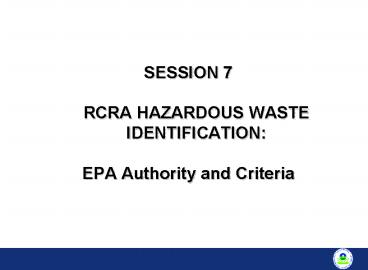SESSION 7 RCRA HAZARDOUS WASTE IDENTIFICATION: - PowerPoint PPT Presentation
1 / 12
Title:
SESSION 7 RCRA HAZARDOUS WASTE IDENTIFICATION:
Description:
... or the environment when improperly treated, stored, transported, disposed of, ... health and the environment when improperly managed (as determined by risk ... – PowerPoint PPT presentation
Number of Views:243
Avg rating:3.0/5.0
Title: SESSION 7 RCRA HAZARDOUS WASTE IDENTIFICATION:
1
- SESSION 7RCRA HAZARDOUS WASTE IDENTIFICATION
- EPA Authority and Criteria
2
Agenda Hazardous Waste Identification (HWID)
Introduction and Basics
- EPA Authority
- Criteria for Hazardous Waste
- HWID
- HWID Procedure
3
Hazardous waste is a subset of solid waste
EPA Authority
Solid Wastes
Hazardous Wastes
4
Congress definition of hazardous waste is found
in RCRA 1004(5)
EPA Authority
- Hazardous waste means a solid waste, which
because of its quantity, concentration, or
physical, chemical, or infectious characteristics
may - Cause, or significantly contribute to an increase
in mortality or an increase in serious
irreversible, or incapacitating reversible
illness or - Pose a substantial present or potential hazard to
human health or the environment when improperly
treated, stored, transported, disposed of, or
otherwise managed.
RCRA 1004(5)
5
Congress dictated to EPA certain criteria for
defining what a hazardous waste is
EPA Authority
- In developing criteria for defining a hazardous
waste, EPA had to take into account - Toxicity, persistence, and degradability in
nature - Potential for accumulation in tissue
- Other related factors such as flammability,
corrosiveness, and other hazardous
characteristics
RCRA 3001(a)
6
Congress directed EPA to implement a HWID process
and to identify hazardous constituents
EPA Authority
- EPA had to promulgate regulations that
- Identified the characteristics of hazardous waste
- Listed particular hazardous wastes that would be
- subject to the provisions of this subtitle
- EPA also had to identify or list hazardous wastes
that contained certain constituents (such as
identified carcinogens, mutagens, or teratogens)
at levels that endanger human health
RCRA 3001(b)(1)
7
EPAs criteria for determining hazardous waste
characteristics
Criteria for Hazardous Waste
- EPA chose characteristics that were
- Definable in terms of physical, chemical, or
other properties - Defined as hazardous waste, based on Congress
definition under RCRA - Measurable by standardized, uncomplicated, and
available testing protocols
40 CFR 261.10
8
EPAs criteria for listing hazardous waste
Criteria for Hazardous Waste
- EPA chose to list wastes that
- Exhibited a characteristic
- Were considered acute hazardous wastes
- Were considered toxic hazardous wastes
40 CFR 261.11(a)
9
EPAs criteria for listing waste that is acute or
toxic
Criteria for Hazardous Waste
- Acute listings
- Fatal to humans in low doses
- Certain dermal and inhalation toxicities
- Capable of causing or significantly contributing
to an increase in serious irreversible, or
incapacitating reversible illness
- Toxic Listings
- Contain a Part 261, Appendix VIII constituent
- Pose a substantial threat to human health and the
environment when improperly managed (as
determined by risk factors)
40 CFR 261.11(a)(2) (3)
10
Toxic listings contain hazardous constituents
Criteria for Hazardous Waste
- Part 261, Appendix VIII is a list of 372
hazardous constituents drawn from - 307(a) and 311 of Clean Water Act (CWA)
- 112 of Clean Air Act (CAA)
- 1412 of Safe Drinking Water Act (SDWA)
- EPAs Carcinogen Assessment Group
- National Institute of Occupational Safety and
Health (NIOSH) Registry of Toxic Effects of
Chemical Substances - Department of Transportation (DOT)
11
The HWID process consists of four steps
HWID Procedure
40 CFR 262.11
12
The HWID process starts with determining if a
solid waste meets a listing description
HWID Procedure
- F List (non-specific sources)
- Solvents, electroplating, dioxins
- K List (specific sources)
- Organic chemical manufacturing, explosives,
petroleum refining - P List
- Acute commercial chemical products (CCPs)
- U List
- Non-acute CCPs































